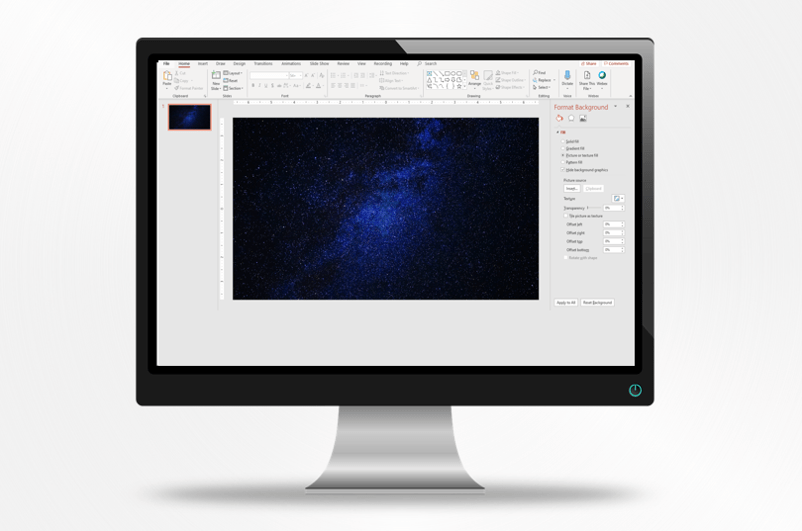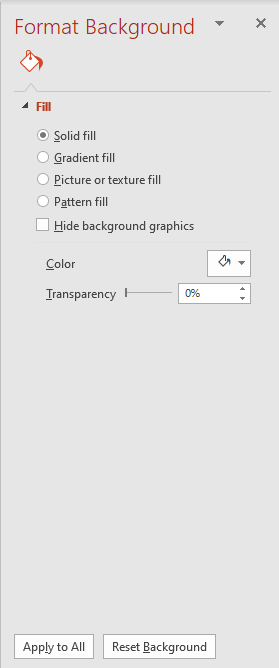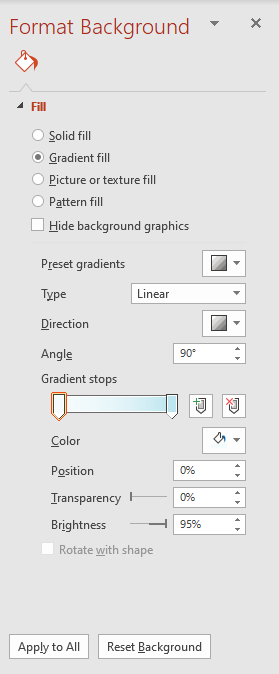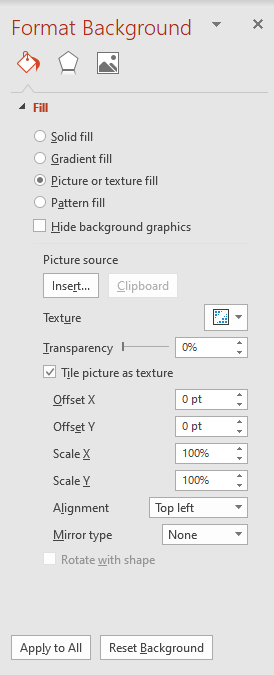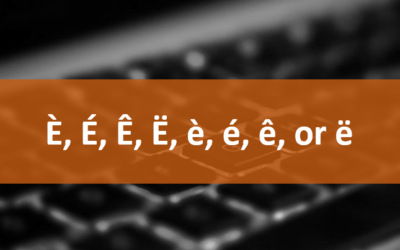Change the Background of PowerPoint Slides to a Color, Gradient or Picture
by Avantix Learning Team | Updated September 7, 2023
Applies to: Microsoft® PowerPoint® 2013, 2016, 2019, 2021 and 365 (Windows)
In PowerPoint, you can change the background of individual slides, selected slides based on a layout, or all slides based on a Slide Master. Slide backgrounds can be changed to a color, pattern, gradient, texture or picture. In this article, we'll review applying color, gradient and picture backgrounds.
It's important to understand that every PowerPoint presentation (or template) uses themes. The Document Theme (or overall theme) includes a Font Theme, a Color Theme, an Effect Theme and a Slide Master with a set of layouts (typically one master set). Some themes may contain multiple slide masters which can be tricky to use.
You can apply a theme in Normal View by clicking the Design tab in the Ribbon and then clicking a theme in the Themes gallery. You can also apply a Font Theme, Color Theme, or Effect Theme by clicking the Design tab in the Ribbon, clicking the More arrow in Variants and then selecting one of the theme options. If you change the Document Theme or Color Theme, you may change the background of all of your slides.
Recommended article: How to Remove the Background From an Image in PowerPoint (2 Ways)
Do you want to learn more about PowerPoint? Check out our virtual classroom or in-person PowerPoint courses >
Note that applying slide backgrounds is different from inserting a picture on a slide, resizing it and sending it to the back.
In this article, we're using the Format Background task pane to change slide backgrounds, not the Ribbon.
Change the background of a slide to a color
To change the background color of a slide:
- Go to Normal View (you may need to click the Normal button on the bottom right of the screen).
- Display the slide with the slide background you want to change.
- Right-click a blank part of the slide. A drop-down menu appears.
- Select Format Background. The Format Background task pane appears.
- If necessary, click the Fill icon at the top of the task pane.
- Click Solid Color and then select a color from the color drop-down menu. Do not click Apply to All.
In the example below, a solid color is selected for the background:
Change the background of a slide to a gradient
To change the background of a slide to a gradient:
- Go to Normal View (click the Normal button on the bottom right of the screen).
- Display the slide with the slide background you want to change.
- Right-click a blank part of the slide. A drop-down menu appears.
- Select Format Background. The Format Background task pane appears.
- If necessary, click the Fill icon at the top of the task pane.
- Click Gradient fill.
- If you want to use a Preset gradient, select one from the Preset drop-down menu.
- If you want to change the type of gradient, select a type from the Type drop-down menu. These include Linear, Radial, Rectangular or Path.
- If you want to change the direction of the gradient, select a direction from the Direction drop-down menu.
- If you want to set an angle (for linear gradients), select an angle from the Angle drop-down menu.
- If you want to change the color of a gradient stop, under Gradient stops, click the stop and select a color from the Color drop-down menu. Repeat for other gradient stops. To delete a stop, click it and click the Remove Gradient Stop (x) to the right of the gradient stops. It's usually easiest to have 2 stops. You can also change the Position, Transparency and Brightness settings for each gradient stop. Do not click Apply to All.
In the Format background task pane below, note there are two stop points with different colors:
Change the background of a slide to a picture
To change the background of a slide to a picture:
- Go to Normal View (click the Normal button on the bottom right of the screen).
- Display the slide with the slide background you want to change.
- Right-click a blank part of the slide. A drop-down menu appears.
- Select Format Background. The Format Background task pane appears.
- If necessary, click the Fill icon at the top of the task pane.
- Click Picture or Texture Fill.
- In PowerPoint 2013 or 2016, under Insert, click Picture from File. If a dialog box appears, click Offline. In PowerPoint 2019 or 365, under Picture Source, click Insert. A dialog box appears. Click Insert from File.
- Navigate to the folder with the picture you want to use.
- Double-click the picture. Do not click Apply to All.
Note that Picture or texture fill is selected for the background in the following example (in PowerPoint 365 which is similar in 2013, 2016 and 2019):
Change the background of multiple slides in Slide Master View
If you change the background of a Slide Master, all of the layouts based on that Slide Master (in the Slide Master set) should change unless an individual layout's background has been changed. In most presentations, there is only one Slide Master and its associated layouts but there can be more than one Slide Master. Here, we'll assume there is only one Slide Master.
Change the background of all slides to a color using the Slide Master
To change the background color of all slides using the Slide Master:
- If you are not in Slide Master View, click the View tab in the Ribbon and then click Slide Master in the Master Views group.
- Click the Slide Master on the top left in the thumbnails (this thumbnail is larger and normally appears with a 1 beside it).
- Right-click a blank area on the slide on the right. A drop-down menu appears.
- Select Format Background. The Format Background task pane appears.
- If necessary, click the Fill icon at the top of the task pane.
- Click Solid Color and then select a color from the color drop-down menu.
- Go to Normal View by clicking the Normal button on the bottom right of the screen to view the changes.
In the example below, a solid color is selected for the background:
Change the background of all slides to a gradient using the Slide Master
To change the background of all slides to a gradient using the Slide Master:
- If you are not in Slide Master View, click the View tab in the Ribbon and then click Slide Master in the Master Views group.
- Click the Slide Master on the top left in the thumbnails (this thumbnail is larger and normally appears with a 1 beside it).
- Right-click a blank area on the slide on the right. A drop-down menu appears.
- Select Format Background. The Format Background task pane appears.
- If necessary, click the Fill icon at the top of the task pane.
- Click Gradient fill.
- If you want to use a Preset gradient, select one from the Preset drop-down menu.
- If you want to change the type of gradient, select a type from the Type drop-down menu. These include Linear, Radial, Rectangular or Path.
- If you want to change the direction of the gradient, select a direction from the Direction drop-down menu.
- If you want to set an angle (for linear gradients), select an angle from the Angle drop-down menu.
- If you want to change the color of a gradient stop, under Gradient stops, click the stop and select a color from the Color drop-down menu. Repeat for other gradient stops. To delete a stop, click it and click the Remove Gradient Stop (x) to the right of the gradient stops. It's usually easiest to have 2 stops. You can also change the Position, Transparency and Brightness settings for each gradient stop. Do not click Apply to All.
- Go to Normal View by clicking the Normal button on the bottom right of the screen to view the changes.
In the Format background task pane below, note there are two stop points with different colors:
Change the background of all slides to a picture using the Slide Master
To change the background of all slides to a picture (stored on your hard drive or a shared drive) using the Slide Master:
- If you are not in Slide Master View, click the View tab in the Ribbon and then click Slide Master in the Master Views group.
- Click the Slide Master on the top left in the thumbnails (this thumbnail is larger and normally appears with a 1 beside it).
- Right-click a blank area on the slide on the right. A drop-down menu appears.
- Select Format Background. The Format Background task pane appears.
- If necessary, click the Fill icon at the top of the task pane.
- Click Picture or Texture Fill.
- In PowerPoint 2013 or 2016, under Insert, click Picture from File. If a dialog box appears, click Offline. In PowerPoint 2019 or 365, under Picture Source, click Insert. A dialog box appears. Click Insert from File.
- Navigate to the folder with the picture you want to use.
- Double-click the picture.
- Go to Normal View by clicking the Normal button on the bottom right of the screen to view the changes.
Note that Picture or texture fill is selected for the background in the following example (in PowerPoint 365 which is similar in 2013, 2016 and 2019):
Change the background of slides using a specific layout in Slide Master View
In a PowerPoint presentation, every slide is assigned a layout. If you change the background of a slide layout in Slide Master View, all slides using that layout should change. However, if a slide background has been changed for an individual slide in Normal View, it no longer follows the background of its associated slide layout.
To apply or change a slide's layout:
- In Normal View, display the slide with the layout you want to change
- Click the Home tab in the Ribbon and select Layout in the Slides group. A drop-down menu appears.
- Click the layout you want to apply.
Change the background of slides using a specific layout to a color
To change the background color of slides using a specific layout in Slide Master View:
- If you are not in Slide Master View, click the View tab in the Ribbon and then click Slide Master in the Master Views group.
- Click the desired slide layout on the left in the thumbnails. When you point to a slide layout, a pop-up appears with the name of the layout.
- Right-click a blank area on the slide on the right. A drop-down menu appears.
- Select Format Background. The Format Background task pane appears.
- If necessary, click the Fill icon at the top of the task pane.
- Click Solid Color and then select a color from the color drop-down menu. Do not click Apply to All.
- Go to Normal View by clicking the Normal button on the bottom right of the screen to view the changes.
In the example below, a solid color is selected for the background:
Change the background of slides using a specific layout to a gradient
To change the background of slides using a specific layout to a gradient in Slide Master View:
- If you are not in Slide Master View, click the View tab in the Ribbon and then click Slide Master in the Master Views group.
- Click the desired slide layout on the left in the thumbnails. When you point to a slide layout, a pop-up appears with the name of the layout.
- Right-click a blank area on the slide on the right. A drop-down menu appears.
- Select Format Background. The Format Background task pane appears.
- If necessary, click the Fill icon at the top of the task pane.
- Click Gradient fill.
- If you want to use a Preset gradient, select one from the Preset drop-down menu.
- If you want to change the type of gradient, select a type from the Type drop-down menu. These include Linear, Radial, Rectangular or Path.
- If you want to change the direction of the gradient, select a direction from the Direction drop-down menu.
- If you want to set an angle (for linear gradients), select an angle from the Angle drop-down menu.
- If you want to change the color of a gradient stop, under Gradient stops, click the stop and select a color from the Color drop-down menu. Repeat for other gradient stops. To delete a stop, click it and click the Remove Gradient Stop (x) to the right of the gradient stops. It's usually easiest to have 2 stops. You can also change the Position, Transparency and Brightness settings for each gradient stop. Do not click Apply to All.
- Go to Normal View by clicking the Normal button on the bottom right of the screen to view the changes.
In the Format background task pane below, note there are two stop points with different colors:
Note that Picture or texture fill is selected for the background in the following example (in PowerPoint 365 which is similar in 2013, 2016 and 2019):
Change the background of slides using a specific layout to a picture
To change the background picture of slides using a specific layout in Slide Master View:
- If you are not in Slide Master View, click the View tab in the Ribbon and then click Slide Master in the Master Views group.
- Click the desired slide layout on the left in the thumbnails. When you point to a slide layout, a pop-up appears with the name of the layout.
- Right-click a blank area on the slide on the right. A drop-down menu appears.
- Select Format Background. The Format Background task pane appears.
- If necessary, click the Fill icon at the top of the task pane.
- Click Picture or Texture Fill.
- In PowerPoint 2013 or 2016, under Insert, click Picture from File. If a dialog box appears, click Offline. In PowerPoint 2019 or 365, under Picture Source, click Insert. A dialog box appears. Click Insert from File.
- Navigate to the folder with the picture you want to use.
- Double-click the picture. Do not click Apply to All.
- Go to Normal View by clicking the Normal button on the bottom right of the screen to view the changes.
Note that Picture or texture fill is selected for the background (in PowerPoint 365 which is very similar in 2013, 2016 and 2019):
Summary and considerations
You can use the Ribbon to apply backgrounds as well but the Format Background task pane offers the most flexibility.
if you want to change the background of multiple slides, it's usually best to change either the Slide Master or layouts in Slide Master View.
A picture background can be problematic if you want to format, crop or animate the picture. As an alternative, you may want to consider inserting a picture and sending it to the back as opposed to changing the background to a picture. You an insert pictures on a slide in both Normal View or on a slide master or layouts in Slide Master View.
If you are having difficulty editing slide backgrounds, you may have multiple masters and associated layouts. In Slide Master View, scroll down on the left in the thumbnails to see if there are more masters and associated layouts. Right-click any master and / or layouts that you don't need and select Delete from the drop-down menu. Note that you cannot delete a layout or master that is being used by one or more slides in Normal View.
Subscribe to get more articles like this one
Did you find this article helpful? If you would like to receive new articles, JOIN our email list.
More resources
How to Add Slide Numbers in PowerPoint
10 Great PowerPoint Drawing Tricks and Shortcuts
PowerPoint Slide Show Shortcuts (50+ Keyboard Shortcuts)
How to Hide or Unhide Slides in PowerPoint (with Shortcuts)
How to Change Picture Brightness or Contrast in PowerPoint (2 Ways)
Related courses
Microsoft PowerPoint: Intermediate / Advanced
Microsoft PowerPoint: Design for Non-Designers
Microsoft PowerPoint: Animations Bootcamp
Our instructor-led courses are delivered in virtual classroom format or at our downtown Toronto location at 18 King Street East, Suite 1400, Toronto, Ontario, Canada (some in-person classroom courses may also be delivered at an alternate downtown Toronto location). Contact us at info@avantixlearning.ca if you'd like to arrange custom instructor-led virtual classroom or onsite training on a date that's convenient for you.
Copyright 2024 Avantix® Learning
You may also like
How to Insert or Type E with an Accent Mark in PowerPoint (È, É, Ê, Ë, è, é, ê, or ë)
You can insert or type e with an accent mark in PowerPoint using built-in tools or keyboard shortcuts (including Alt code shortcuts). The letter e can be inserted with an accent in both upper or lower case in text boxes or placeholders on slides, the slide master or layouts. The following are common accents in upper or lower case – È, É, Ê, Ë, è, é, ê, or ë.
How to Fade a Picture or Part of a Picture in PowerPoint (Using a Gradient)
You can fade a picture in PowerPoint by drawing a rectangle shape on top of the picture and then filling the rectangle with a gradient from opaque to transparent. This technique is often used to fade an image into the background of a slide. Since the rectangle is placed on top of the image and then text may be placed on top of the rectangle, you may need to reorder the objects.
How to Lock an Image, Shape or Other Object in PowerPoint
You can now lock an image, shape or other object in PowerPoint. Objects can be locked in Normal View or Slide Master View. Only PowerPoint 365 users can lock objects to prevent moving and resizing. This is helpful if you want to select and move other objects on the slide or prevent others from moving or resizing an object. You can lock items using the context menu or the Selection Pane.
Microsoft, the Microsoft logo, Microsoft Office and related Microsoft applications and logos are registered trademarks of Microsoft Corporation in Canada, US and other countries. All other trademarks are the property of the registered owners.
Avantix Learning |18 King Street East, Suite 1400, Toronto, Ontario, Canada M5C 1C4 | Contact us at info@avantixlearning.ca
